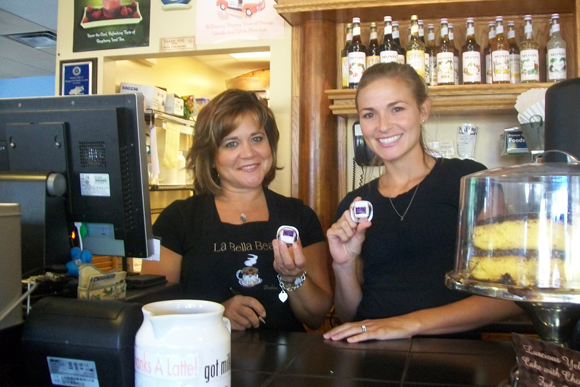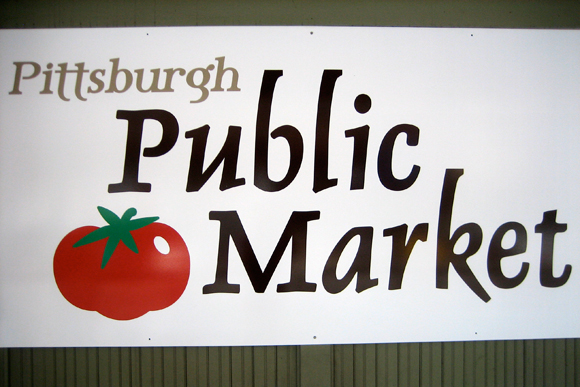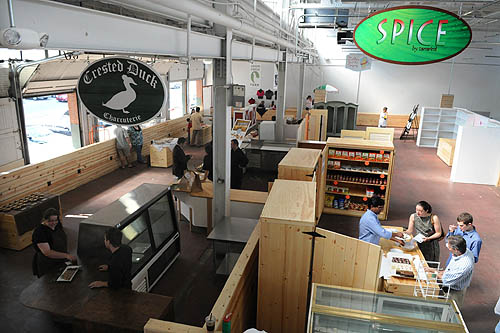
Category Archive: Downtown Development
-
Money Tagged for I-579 Project Could Be Used at New Arena
By Jeremy Boren
PITTSBURGH TRIBUNE-REVIEW
Monday, September 13, 2010Federal money intended to plug an unsightly concrete gap next to Interstate 579 might be used at Consol Energy Center instead.
At the request of the Urban Redevelopment Authority of Pittsburgh, Sen. Bob Casey proposed redirecting the $974,000 earmark to pay for most of a walkway that would hug the exterior of the Penguins’ new home and connect its Fifth Avenue and Centre Avenue entrances.
People working on a master plan for the Lower Hill District and trying to preserve the Civic Arena question whether a Consol walkway is the best use of federal money in a neighborhood struggling with crime and poverty.
“If we’re going to move it around anyway, we need it for public safety on Centre Avenue,” said Carl Redwood, founder of the Hill District Consensus Group. “That takes priority.”
Redwood supports the concept of the $1.5 million walkway at Consol but said his group lobbied city police to address concerns about drug deals occurring near the Zone 2 station on Centre, not far from the arena.
Casey, D-Pa., declined to say whether he believes there’s a better use for the money, but he’s aware no consensus exists.
“If there are better ways to target the dollars, we try to be responsive to that. It doesn’t always work,” the senator said. “What I try not to do is to be an urban planner or a local government official. That really has to be a decision made here in Pittsburgh.”
The Consol walkway, dubbed “Curtain Call” by California artist Walter J. Hood, would feature 15-foot-tall stainless-steel curtains, a lighted path and photos of Hill District life embedded in the steel sheets.
URA Executive Director Rob Stephany said an “engineer’s sketch” of the I-579 “cap” project between the Hill District and Downtown would cost an estimated $15 million.
The original application for federal money from Casey’s office touts the cap as “a new urban green space that finally reconnects the Lower Hill District to downtown.”
After learning from the Sports & Exhibition Authority, which owns the new $321 million arena, that it lacked enough money to pay for Curtain Call, URA officials requested the money from Casey, Stephany said.
Rob Pfaffmann, a Downtown architect and frequent critic of the hockey team’s desire to demolish the Civic Arena and develop its 28-acre site, supports Curtain Call. Pfaffmann formed the grass-roots group Reuse the Igloo.
He believes the connection between Fifth and Centre is crucial because walking outside from one side of Consol to the other is difficult.
“Frankly, the Penguins should have paid for it,” Pfaffmann said.
In 2007, the Penguins agreed to contribute $4.1 million a year for 30 years to pay for part of the arena. Pittsburgh’s Rivers Casino pays $7.5 million a year from gambling revenue, and the state funding fueled by casino taxes chips in another $7.5 million a year.
The city Planning Commission required the walkway at the arena, Stephany said, noting the team never wanted anything so elaborate.
“We kind of fell in love with that notion of a public art project and pedestrian way,” he said.
The walkway would be open to everyone, not just hockey fans, he said.
“Will it make for a great experience for people at a game? Yes. Will it make for a great connector for a student on his way to a grocery store? Yes.”
-
Hiding in Plain Sight: A House as Old as Larryville
The house on the southwest corner of 38th St. and Charlotte Street in Lawrenceville is up for sale. It was bult a decade after Lawrenceville became a town in 1814.
We know this because house historian Carol Peterson, a denizen of Larryville, researched the records. The house you see now — ruddy-colored clapboards, patched in part with old tin advertisements — encloses the original log home that was built in the 1820s. The “new” part is from the 1870s. That’s Michael Connors in front of it. Michael has been part of the Lawrenceville Historical Sociaty’s efforts over the years to get it, and to have it renovated.
Read Michael’s “Next Page” in the Post-Gazette on Sept. 12 for a story about one of the buildings past inhibitants, a teenager who packed munitions and died in the deadly arsenal explosion of 1882. And, by the way, thanks to Matt Smith, who was walking along with a smart phone and agreed to take the photo you see. (So, OK, the sun was in the wrong place.)
For some time, heavy hitters including the Pittsburgh History and Landmarks Foundation, Sen. Jim Ferlo and other public officials, were at least cheering on the historical society’s effort, Michael tells me.
Arthur Ziegler, president of Landmarks, said the interest and needed money could not be reconciled. “We don’t have many log houses left and we would like to save them,” he said, “but this had been so changed over the years, to put it back the way it was would have meant cutting new logs.”
The historical society “knew it was way beyond our ability” to afford and renovate, Michael said.
It is owned by a limited partnership. Historical Society members toured it a few years ago when the owners wanted $39,000. We’re trying to find out the asking price from the Realtor.
This building was part of the original town of Lawrenceville that composer Stephen Foster’s father subdivided. In 1841, Lawrenceville town was carved out of Pitt Township roughly from 38th to 41st Streets and from Woolslayer to the Allegheny River, Carol said. Lawrenceville was incorporated as a borough in 1834.
“Just think that someone in this house could have walked up the street to see the Marquis de Lafayette when he visited Pittsburgh” in 1825, Michael said. In case history isn’t your subject, Lafayette was a hero of both the French and American revolutions and knew George Washington.
He was our first president.
Michael said his dream is that UPMC, whose Children’s Hospital presence is “the biggest and newest” in the neighborhood, offers the needed largesse “for the smallest and oldest” and help Lawrenceville showcase one of its original structures, which could be an attraction for visitors to the hospital.
Walkabout is putting it out there, like a butterfly wish that might merge with the fluttering fancy of the right person…or institution.
-
Healthy Downtown Business Program Shaping Up Eight Communities in Allegheny County
Wednesday, September 08, 2010?
Pop City Media
Allegheny Together, a small business revitalization organization, launched the Healthy Downtown Business Program last Wednesday to encourage employees and residents of eight communities to explore their commercial districts by foot.
The program has distributed walking maps to small businesses in Bellevue, Bridgevale, Coraopolis, Elizabeth, Stowe Township, Swissvale, Tarentum, and Verona, which encourage people to get physically fit while supporting downtown revitalization. In addition, they have also distributed walking logs, which allow participants to chart how much they walk through their downtown area.
“We have over 600 people signed up, which exceeds what we anticipated,” says Jessica Mooney, assistant manager of business development for Allegheny County Economic Development.
Business employees can look forward to special awards for their log efforts. At the end of September, the logs will be returned to Allegheny Together, and prizes will be given to the “healthiest downtown business” and “healthiest downtown business employee” in each community.
Allegheny Together was started in 2007 by Allegheny Economic Development in order to “reinvigorate small businesses by bringing residents back to our traditional, walkable shopping districts,” says Dan Onorato, county executive for Allegheny County.
Financial support for the Healthy Downtown Business Program comes form a combination of public and private funds made possible by the Health Department. Allegheny Together hopes to expand the program in the future, by offering more features, such as free pedometers and even more detailed walking maps.
Sign up to receive Pop City each week.
Source: Jessica Mooney, assistant manager of business development for Allegheny County Economic Development
Dan Onorato, county executive for Allegheny County
Writer: John FarleyPhotograph courtesy Mara Dowdy
-
The Pittsburgh Public Market Celebrates its Grand Opening this Friday
Wednesday, September 08, 2010
Pop City Media
If you haven’t been to the Pittsburgh Public Market in the Strip District, which opened softly on September 3rd, be sure to check it out this Friday, September 10th for the official grand opening. The 10,000 square foot space, which hosts over 40 vendors, is the first public market in Pittsburgh in 45 years.
The market features a diversity of small booth vendors, ranging from big name local operations wanting to fill a specific niche market to energetic startup operations hoping to make a name for themselves by virtue of the $25 per day rents. East End Brewery, for example, will be selling growlers to go. Be sure to pick up Indian seasonings or a meal-to-go from Spice by Tamarind, cure your sweet tooth at the Pittsburgh Candy Company, and grab some of the unique cured meats offered by the Crested Duck Charcuterie. There’s more to the market than food though, with booths like the crafty Babouche, and boutique skin care product vendor Tracy’s Treats.
The Pittsburgh Public Market is the brainchild of Neighbors in the Strip, which established a separate non-profit entity called the Strip District Market Counsel to run the operation. Plans for the market have been in development since 2003, and after extensive fundraising to the tune of $1.3 million and renovation work by architect Robert Indovina, the long awaited market is finally ready to become Pittsburgh’s next major tourist attraction, small business incubator, and community resource.
The market is located in the Produce Terminal Building near 17th and Smallman Streets. The grand opening ceremony will begin at 9 am this Friday. The first 100 visitors will receive a free tote bag, and a variety of entertainers and surprises will fill the building throughout the weekend. We can’t wait!
Sign up to receive Pop City each week.
Source: Becky Rodgers, Executive Director of Neighbors in the Strip
Writer: John FarleyPhotograph copyright John Farley
-
With New Pittsburgh Public Market, City Has Tradition Back
By Margaret Harding
PITTSBURGH TRIBUNE-REVIEW
Tuesday, September 7, 2010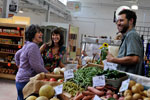
Rosemary Miller, left, of Baldwin and Kelly Miller of Polish Hill, center, talk to Nathan Holmes at his Clarion River Organics booth at the new public market in the Strip on Friday afternoon. Justin Merriman/Pittsburgh Tribune-Review
Visiting the Pittsburgh Public Market the first day it opened took Augie Barrante back more than 60 years.
“I used to work in the old North Side Market when I was 10 years old,” said Barrante, 73, of Wexford. “I helped out with the produce stand.”
The opening weekend of the Pittsburgh Public Market in the Produce Terminal Building along Smallman Street was nothing short of an overwhelming success, with an estimated 6,500 visitors, organizers said.
“I thought there would be 100 people (Friday), and there were 100 people in the first hour,” said Becky Rodgers, executive director of Neighbors in the Strip. “I think everyone coming through is happy to have a market back.”
The market had a “soft opening” last weekend. Its official opening is set for Friday. More than 40 vendors are expected to participate each week, Rodgers said.
“It’s so contemporary,” said Lori Barrante, 54, Augie’s wife. “It has a little bit of everything.”
Pat Cosmano’s booth of olive oils and balsamics, Cosimano e Ferrari, particularly piqued the Barrantes’ interest.
Cosmano, of Rochester, N.Y., said he has worked out of a space at the Rochester Public Market for about eight months and expanded to Pittsburgh after a relative told him about the Strip District market.
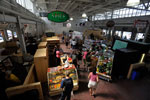
The opening weekend of the Pittsburgh Public Market in the Produce Terminal Building along Smallman Street was nothing short of an overwhelming success, with an estimated 6,500 visitors, organizers said. Justin Merriman/Pittsburgh Tribune-Review
“I’m really impressed with the setup,” Cosmano said. “You have a lot of good vendors in here.”
The Rochester Public Market has about 300 booths in an indoor-outdoor setting. It won the 2010 America’s Favorite Farmers Market contest.
Rodgers expected at least 10 more booths to go up for this weekend’s opening.
“For a lot of people here, this is their second business,” Rodgers said.
Nathan Holmes helps run Clarion River Organics, a business cooperative in its third year that was selling vegetables and dairy products. Holmes said the group will bring in homemade ice cream, milk, meat and some vegetables in the winter.
“It’s really nice to have a place with a cooler,” Holmes said. “It’s exciting and people are excited.”
Teresa and Don Orkoskey of Lawrenceville said the setting reminded them of the market they grew up with in Wheeling, W.Va.
“I like the farmers’ stands,” said Teresa Orkoskey, 29. “It’s protected from the elements, but it doesn’t have that corporate shopping mall feel.”
Pittsburgh Public MarketWhere: Produce Terminal Building, Smallman Street, Strip District
What: Vendors selling items ranging from pierogies, espresso and Italian ice to textiles, olive oils and desserts
Open: Year-round, 9 a.m.-7 p.m. Fridays, 9 a.m.-5 p.m. Saturdays, 10 a.m.-4 p.m. Sundays
Details: pittsburghpublicmarket.org
-
Downtown’s EQT Plaza No Longer on the Block
‘Recapitalization’ shinier than sellingWednesday, September 01, 2010By Mark Belko, Pittsburgh Post-GazetteThe owner of one Downtown building has removed its “for sale” sign.
Rather than sell, New York-based Blackstone Group has decided to retain ownership of EQT Plaza, formerly known as Dominion Tower, and refinance its debt.
“They just decided with the way the markets are today, a recapitalization was a better option for them,” said Gerard Sansosti, executive managing director of HFF Inc. in Pittsburgh, which was marketing the building for sale.
Aaron Stauber, president of New York-based Rugby Realty, which has extensive property holdings in Pittsburgh, said refinancing was an attractive option for building owners these days because of very low interest rates. One advantage to refinancing rather than selling, he noted, is that the owner does not have to pay capital gains taxes.
HFF had announced in February that it was putting the 32-story office building, now the headquarters of EQT Corp., up for sale on behalf of Blackstone, which bought it for $45 million through a sheriff’s sale in 2005.
While HFF had received offers for the 23-year-old building, located on Liberty Avenue, Mr. Sansosti said Blackstone ultimately decided not to sell.
“I think it’s going to be off the market for a while,” he said.
As of February, the 615,942-square-foot office tower was about 96 percent leased. EQT moved into the building from the North Shore last year.
EQT Plaza was one of a handful of high-profile buildings Downtown to go up for sale this year, sparking a wave of publicity and even inquiries from city hall about the reasons for the moves.
Others on the market include the landmark Macy’s department store (formerly Kaufmann’s); the four-building Gateway Center complex, the linchpin of the city’s first renaissance; the Henry W. Oliver Building; the Regional Enterprise Tower, formerly the Alcoa Building; and American Red Cross of Southwestern Pennsylvania building, Boulevard of the Allies.
-
City’s Newest Indoor Market Opens in Strip Next Week
Wednesday, September 01, 2010By Diana Nelson Jones, Pittsburgh Post-GazetteWhen the Pittsburgh Public Market in the Strip opens Friday, patrons will see some tried-and-true faces — La Prima Coffee, the Common Plea and Fudgie Wudgie among them.
But the new indoor market in the Produce Terminal Building on Smallman Street marks the retail debut of a number of the 43 vendors, whose wares will include organic produce, coffee, specialty meats, pastries, Indian food, pierogies, organic teas, local wines, micro brewed beer, skin care products, knitted goods and jewelry.
The Produce Terminal was built in 1926 by the Pennsylvania Railroad. The market house, located between 16th and 17th Streets, features horizontal roof-line skylights and doors that open for a river view. It will be open Fridays from 9 a.m. to 7 p.m., Saturdays from 9 a.m. to 5 p.m. and Sundays from 10 a.m. to 4 p.m. The grand opening festivities are Sept. 10-12.
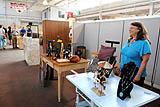
Debbie Jacknin of Jenn's Jems displays her jewelry and other items in her booth at the new Pittsburgh Public Market in the Strip District on Tuesday. Robin Rombach/Post-Gazette
The project began almost nine years ago as a dream of Neighbors in the Strip.
“Eight years, three months and two days,” said Tom Goslin, the Market Council president and owner of American Dispatch.
The dream got state funding in 2005, the same year the Urban Redevelopment Authority, which owns the building, did a feasibility study. The URA invested $100,000. The total price tag of $1.25 million was filled out by federal, state and local foundation money.
“This was part of our neighborhood improvement strategy,” said Becky Rodgers, executive director of Neighbors in the Strip. “It’s been a goal of ours to bring back a piece of history to Pittsburgh.”
The city once had four enclosed marketplaces. The last of them closed in 1965 to create Allegheny Center Mall.
Several years ago, the board of Neighbors in the Strip visited existing markets: the Reading Terminal Market in Philadelphia, the West Side Market in Cleveland and the Central Market in Lancaster, hoping to bring a similar concept to the Strip.
Cindy Cassell, market manager, said the market council selected vendors “in the context of the entire Strip. We had a series of meetings with existing businesses and came up with a list of things that would contribute the most diversity to the Strip.”
Edith Davis and Eartha Sewell, of Edith and Eartha Textiles, are among several woman- and minority-owned businesses in the marketplace. They were in a knitting group, then started knitting together, specializing in scarves and wraps.
“People said they wanted to buy them” said Ms. Sewell, “so we thought we could make a business out of it. Then this opportunity came up. You know what they say: Do what you love.”
The first vendor’s space in the markethouse is Kevin and Adam Costa’s Crested Duck Charcuterie, where the brothers are opening their first specialty meat shop. Kevin was mentored by a chef during a stint in Cincinnati, “then I just played with it and tried things. I did vegan baking at a farmer’s market in Indianapolis” before returning home to Pittsburgh last year.
Debbie Jacknin’s 23-year-old daughter Jenn began making jewelry when she was 14. “She taught me,” said Ms. Jacknin. “We’ve done craft shows before but nothing like this,” their first retail presence — Jenn’s Jems.
“A friend told me about this marketplace. I had to submit a video. And they accepted us.”
Diana Nelson Jones: djones@post-gazette.com or 412-263-1626. -
Public Market in Strip to Open Sept. 10, Feature Specialty Items
By Michael Machosky, PITTSBURGH TRIBUNE-REVIEW
Tuesday, August 31, 2010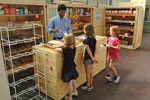
Siblings (from left), Xanthe Schandelmeier, 5; Coco, 9; and Vivienne, 7, of Squirrel Hill, sample sweets at Prasad Potluri's Spice by Tamarind booth in the Pittsburgh Public Market. More than 40 vendors will showcase their wares in a 10,000-square-foot area of the Produce Terminal Building. The grand opening will be Sept.10. The market will be open Fridays, Saturdays and Sundays. Heidi Murrin | Tribune-Review
From homemade pierogies and duck pate with pistachios and fresh herbs to old-school Italian ice and locally-brewed beer — the Pittsburgh Public Market is so close, you can almost taste it.
“It will be 45 years in November since Pittsburgh had a public market,” said Becky Rodgers, executive director of Neighbors in the Strip, who vividly remembers the last one — the long-demolished North Side Market House. “My great uncle Bob was a butcher there. My whole family used to go — it was like a sight-sound-smell extravaganza.”
Starting with a soft opening Friday, the long-delayed Pittsburgh Public Market finally will open to the public. On Sept. 10, there will be a clamorous Grand Opening marked by the ringing of bells — the public is invited to bring their own to add the racket.
Unlike Pittsburgh’s seasonal farmers markets, this indoor market will be open every weekend year-round. The $1.3-milllion project will have more than 40 vendors in 10,000 square feet of space — which is only a small slice of the blocks-long Produce Terminal Building along Smallman Street, where it is housed. The entrance is near 17th Street.
It’s been a delicate balancing act from the start, which began in 2001. Spaces from 6,500 square feet to 30,000 square feet were considered. And finding a way to avoid diverting business from the Strip’s established food purveyors was a major concern.
“You’ll notice we don’t have a fish place in our market — that’s a very usual kind of thing to have in a market,” said Cindy Cassell, the market manager for Neighbors in the Strip. “We don’t have a cheese place. We’re really working hard not to replicate existing niche markets.”
Vendors quite literally are all over the map — from Gosia’s Pierogies to Sito’s Mediteranean dressings, to Ekh’s authentic Indian vegetarian dishes, to Mushrooms for Life, foraged from around Western Pennsylvania.
Kevin Costa was slicing up duck pate and “Gin & Juice Salami” Tuesday morning at the Crested Duck Charcuterie, a specialty meat market with a booth near the entrance.
“We wanted to start our own business, but it would have been impossible to duplicate the foot traffic of the Strip, so this is perfect,” Costa said.
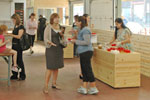
On Sept. 10, the PIttsburgh Public Market will open for business inside the Produce Terminal Building in the Strip District. More than 40 vendors will showcase their wares with everything from baked goods to artwork, barbecues to microbrews. Heidi Murrin | Tribune-Review
Starting a business is a lot less daunting for vendors when they’re paying $25 a day for a 10-foot-by-6-foot booth or $50 a day for a 10-foot-square booth.
“One of our challenges has been to get the concept across that, while this is not necessarily full-time, it’s also not a farmer’s market where you just show up and put your tablecloth down,” Cassell said. “It’s a little more permanent than that. So there is some planning involved for your booth. The booths are small, but from a financial perspective, I think it’s very accessible for a new business.
“We do have a lot of startups that are coming in,” she said. “That’s one of our goals, to incubate new businesses. And you know everything will be realized when they grow up and need a storefront, and can, hopefully, take an empty storefront in the neighborhood.”
Other vendors just want a little more visibility.
The Spice by Tamarind booth stocks Indian spices, snacks, chutneys, ready-to-eat meals and specialties like eggless cakes. Owner Prasad Potluri runs several Indian restaurants and small grocers in the region.
“It’s to make people aware of the restaurants and food,” Potluri said of the reason behind his participation.
For some, it’s simply a way to make it easier for customers to find their product.
Scott Smith, of East End Brewery, always assumed most of the sales for his Big Hop IPA and Black Strap Stout would be wholesale to bars and restaurants. But craft-beer fans just kept searching out the tiny, out-of-the-way brewery.
“We’re in an unmarked building in Homewood, and half our business is walk-in traffic,” Smith said.
Now, customers can sample Fat Gary Nut Brown Ale and Pedal Pale Ale at the Pittsburgh Public Market, and fill up their growlers to take home.
Not everything in the market is edible.
Babouche sells Moroccan crafts, jewelry, scarves and leather goods. Iron Eden is renowned for beautiful ironwork — flowers, trellises, sculpture — often made from recycled scrap metal. Jenn’s Jems features knit and crocheted items, and handmade jewelry.
Markets in other cities — like Cleveland’s West Side Market and Seattle’s Pike Place Market — have become first-day tourist attractions.
The Pittsburgh Public Market is starting on a much smaller scale, of course, but drawing new shoppers to the Strip is part of the plan.
“When we had Campos do a consumer market survey for us in 2006, at that time, we were planning for about 30,000 square feet,” Cassell said. “According to the consumer survey, it would add about 12,000 additional shoppers to the Strip every week. Now we’re scaled back in 10,000 square feet. But one of our goals is to increase the customer base for the entire Strip.”
Pittsburgh Public MarketWhen: Opens Friday, with Grand Opening Festivities Sept. 10-12
Hours: 9 a.m.-7 p.m. Fridays, 9 a.m.-5 p.m. Saturdays, 10 a.m.-4 p.m. Sundays
Where: 17th and Smallman streets, Strip District
Details: 412-281-4505 or website

